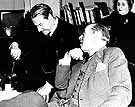
|
|
|

|

|

|

|
|
Click on an image to see a larger, more detailed picture.
|
|
|
|
|
| 1943: Death and Resistance |

|
pg. 502 |

|
|
|
|
| |
 Rabbi Stephen S. Wise (left) converses with U.S. Representative Sol Bloom of New York during a hearing of the House Foreign Relations Committee. Wise's tireless efforts on behalf of European Jewry brought little relief for his persecuted brethren. At this December 1943 hearing, Rabbi Wise reiterated a six-point program that he had introduced eight months earlier at the Bermuda Conference. Those points called upon Britain to open Palestine to Jewish immigration. British opposition prevented the idea from ever being seriously considered.
Rabbi Stephen S. Wise (left) converses with U.S. Representative Sol Bloom of New York during a hearing of the House Foreign Relations Committee. Wise's tireless efforts on behalf of European Jewry brought little relief for his persecuted brethren. At this December 1943 hearing, Rabbi Wise reiterated a six-point program that he had introduced eight months earlier at the Bermuda Conference. Those points called upon Britain to open Palestine to Jewish immigration. British opposition prevented the idea from ever being seriously considered.
Photo: AP / Wide World Photo
|
 The SS staff of the Neuengamme, Germany, concentration camp celebrates Christmas with their families in what is believed to be 1943 or '44. The war and the "Final Solution" did not prevent the camp staff from taking time from their duties to share the spirit of the season. Throughout the war, the SS strove to maintain normal routines for camp guards and their families.
The SS staff of the Neuengamme, Germany, concentration camp celebrates Christmas with their families in what is believed to be 1943 or '44. The war and the "Final Solution" did not prevent the camp staff from taking time from their duties to share the spirit of the season. Throughout the war, the SS strove to maintain normal routines for camp guards and their families.
Photo: KZ-Gedenkstņtte Neuengamme / United States Holocaust Memorial Museum Photo Archive
|
 Partisan Life
Partisan Life
During the Second World War, tens of thousands of men and women joined partisan forces that operated primarily in Eastern Europe and the Balkans. Whether they operated alone, teamed with family members, or belonged to secular nationalist units, partisan fighters lived a precarious and dangerous existence. Many partisans based themselves in the forested regions of Eastern Europe, surviving on captured and foraged food. The need to avoid detection prevented them from building permanent structures. They sheltered in dugouts or slept under the cover of branches and leaves. The long winter nights were especially brutal, for fires were a luxury that clandestine partisan fighters could not afford. Partisan life differed for Jews and gentiles. Whereas gentile partisans could vanish from the scene by seeking shelter from local residents, very few Eastern Europeans willingly sheltered and fed Jewish partisans. Having escaped life in a ghetto to become a partisan, Jews had no neutral area where they could live unmolested by the Nazi authorities. Jewish partisans were hunted by the Nazis and often hated by the local inhabitants.
Photo: Jerzy Tomaszewski / United States Holocaust Memorial Museum Photo Archive
|
|

|

|

|

|
 December 22, 1943: The Gestapo discovers 62 Jews hiding in a cellar of a building on Krolewska Street in Warsaw. All are murdered.
December 22, 1943: The Gestapo discovers 62 Jews hiding in a cellar of a building on Krolewska Street in Warsaw. All are murdered.
|
 December 22, 1943: United States Secretary of the Treasury Henry Morgenthau confronts U.S. Assistant Secretary of State Breckinridge Long, telling him to his face that "the impression is all around that you, particularly, are antisemitic!"
December 22, 1943: United States Secretary of the Treasury Henry Morgenthau confronts U.S. Assistant Secretary of State Breckinridge Long, telling him to his face that "the impression is all around that you, particularly, are antisemitic!"
|
 December 23, 1943: The Jewish community at Pinsk, Poland, is liquidated.
December 23, 1943: The Jewish community at Pinsk, Poland, is liquidated.
|
 December 23, 1943: U.S. Secretary of the Treasury Henry Morgenthau is informed by his staff that, "when you get through with it, the [State Department's] attitude to date is no different from Hitler's attitude."
December 23, 1943: U.S. Secretary of the Treasury Henry Morgenthau is informed by his staff that, "when you get through with it, the [State Department's] attitude to date is no different from Hitler's attitude."
|
|
|
|
|
| 1943: Death and Resistance |

|
pg. 502 |

|
|
The Holocaust Chronicle
© 2009 Publications International, Ltd.
|
|
